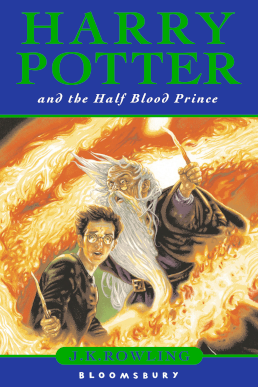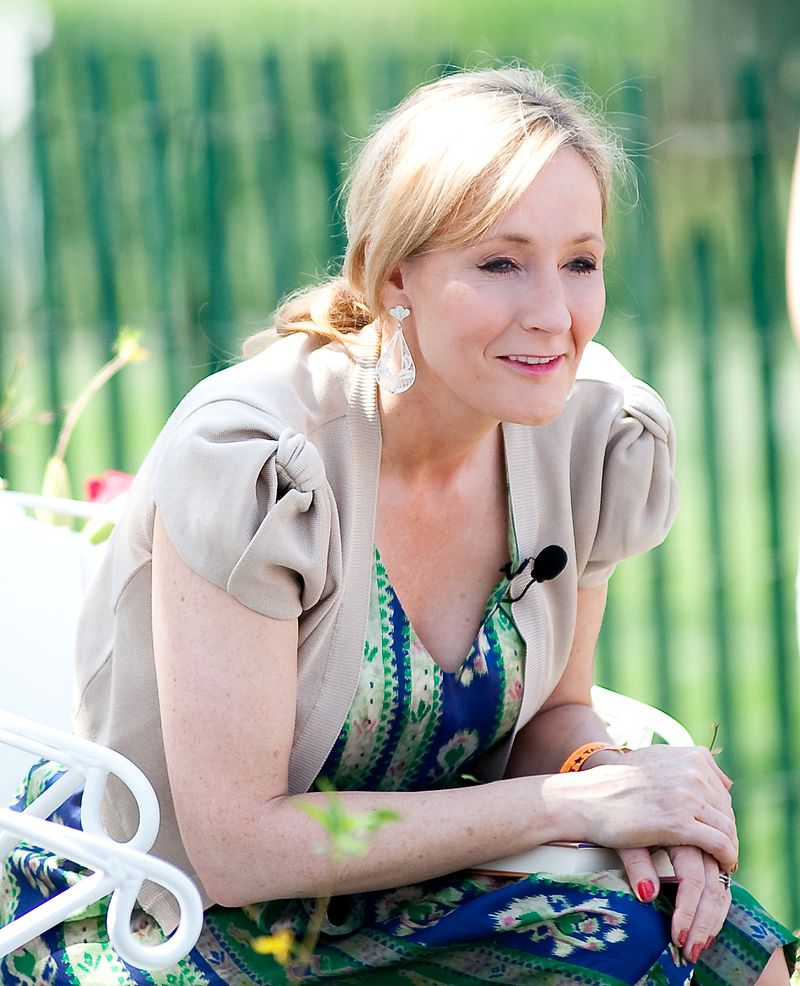Title of the work
Country of the First Edition
Country/countries of popularity
Original Language
First Edition Date
First Edition Details
J. K. Rowling, Harry Potter and the Half-Blood Prince. London: Bloomsbury, 2005, 607 pp.
ISBN
Awards
2005 – Quill Children’s Chapter/Middle Grade Book of the Year;
2006 – Royal Mail Award for Scottish Children’s Books for ages 8–12;
2006 – British Book Award WH Smith Book of the Year;
2006 – Nickelodeon’s Kid’s Choice Award Book of the Year.
Source: siue.edu (accessed: June 14, 2021).
Genre
Fantasy fiction
School story*
Target Audience
Crossover
Cover

Cover of the first edition. Courtesy of Bloomsbury Publishing.
Author of the Entry:
Anna Mik, University of Warsaw, anna.m.mik@gmail.com
Peer-reviewer of the Entry:
Elżbieta Olechowska, University of Warsaw, elzbieta.olechowska@gmail.com
Lisa Maurice, Bar-Ilan University, lisa.maurice@biu.ac.il

Portrait of J. K. Rowling, photographed by Daniel Ogren on April 5, 2010. The file is licensed under the Creative Commons Attribution-Share Alike (accessed: May 25, 2018).
J. K. Rowling
, b. 1965
(Author, Illustrator)
Joanne Kathleen Rowling, was born July 31, 1965 in Yate, Gloucestershire, England. She graduated from the University of Exeter with a degree in French and Classics, she is considered a writer with classical background. After publishing the first Harry Potter book in 1997, she gradually became the best known author of all time.
The Harry Potter septology (1997–2007), is one of the most successful and popular series in the history of children’s literature (Harry Potter and the Philosopher’s Stone sold in 107 million copies). It may be argued that, from the very beginning, the author herself had to expand this world, fill the gaps, and explain all the rules– not only by discussing some issues (later on – mainly on Twitter) or giving guidelines in the interviews but by creating her website Pottermore. Once it was an online platform, where fans could read the series simultaneously with Rowling’s commentary and additions. Now it serves more as commercial space, although Rowling still adds some new elements (e. g. the short history of magical schools in USA).
To give to the devoted fans of Harry something that would allow them to feel the magical bond with the world they want to be a part of she created three books that now exist in both the secondary world of Hogwarts and the primary world where the reader can have a copy in their own hands.
HP Series Spin-offs:
Quidditch Through the Ages by Kennilworthy Whisp (2001), Fantastic Beasts and Where to Find Them by Newton Scamander (2001) and The Tales of Beedle the Bard (2007)* are allegedly copies of books from the world of Harry Potter which include different literary genres and publication formats: history of sport, bestiaries, and collections of fairy tales. These books are not part of the septology, but they provide complementary information about sports, animals and animal-like creatures, and fairy-tales of the Wizarding World. Additionally, they can be interpreted as a device to help convince readers of the reality of the magical world. In these three books, as in the series sensu stricto, J. K. Rowling plays on various levels with great literary traditions, using one of the many features of postmodern literature.
Bio prepared by Anna Mik, University of Warsaw, anna.m.mik@gmail.com
* Hand-written copies were released in 2007, printed ones in 2008.
Adaptations
Movie adaptation: Dir. David Yates, Harry Potter and the Half-Blood Prince, Warner Bros. Pictures, 2009.
Video game based on the novel and the movie: Harry Potter and the Order of Phoenix, published by Electronic Arts, composer: James Hannigan, 2009.
Translation
Multiple languages.
Sequels, Prequels and Spin-offs
Prequel: 5th book: Harry Potter and the Order of the Phoenix, 2003.
Sequel: 7th book: Harry Potter and the Deathly Hallows, 2007.
Summary
The sixth part of the Harry Potter adventures is centered on the relationship between the title character and his mentor, Albus Dumbledore. Together they try to solve the mystery of the indestructibility of Voldemort, the main antagonist of the series, who has returned and once again threatens the magical community. In the magical world in general and at Hogwarts in particular, we can sense an atmosphere of unease – the Dark Lord is once again recruiting Death Eaters and it is not clear whose side anyone is on. One such ambivalent character turns out to be Severus Snape, who together with Draco Malfoy, one of Hogwarts' pro-Voldemort students, forms a mirror image of Dumbledore and Harry's relationship – mentor and follower.
One of the major twists of the novel is Harry's discovery of a potions textbook formerly owned by the eponymous Half-Blood Prince. The book is filled with notes and tips from its former owner, which help Harry to become the best student. After using a mysterious spell from the book against his eternal rival, Draco Malfoy, with disastrous results, Harry decides to get rid of the book. At the end of the novel, it turns out that the Half-Blood Prince is Snape, which adds another dimension to the whole series – Snape becomes a crucial character alongside Harry, which is especially significant in view of the next, final volume.
Over the course of the book, Harry and Dumbledore discover the secret of Voldemort, who, through the use of witchcraft and murder, has placed parts of his soul into seven different objects, called horcruxes, ensuring his immortality. One of these was the diary destroyed by Harry in Harry Potter and the Chamber of Secrets. Another was Marvolo Gaunt’s ring destroyed by Dumbledore. The others still need to be found and destroyed – they will be Harry's final missions.
The book ends with Dumbledore's death at the hands of Snape, who helped Malfoy complete his task (due to being obligated to protect Malfoy by the unbreakable vow he made to Draco’s mother) and thus gained Voldemort's trust. Now Snape is valued by the Death Eaters, and the only wizard of whom Voldemort was afraid is gone.
Analysis
The main element of the world of magic exposed in this part of the series and in an unusual way reaching down to the ancient tradition is horcrux. As already mentioned, it can be any object (or living being) into which a part of the soul has been magically enclosed to ensure immortality. It is a dark spell, which requires that the caster commits a murder. Voldemort, one of the most ruthless wizards, had no problem with mass killings: he divided his soul into seven parts. This makes it significantly more difficult to defeat him.
In the series, the origins of horcruxes is not explained. However, if we look beyond the book, we find J.K. Rowling in an interview (see addenda) talking about a character strongly associated with these objects whose portrait appears on a Chocolate Frog card (a product signed with Rowling's name and with a backstory created by the author; it is a piece of solid chocolate with a collectible card sold at the official wizarding world shop (accessed: May 23, 2022). According to the author, the first sorcerer in history to come up with the spell to create horcruxes was another fictional character, Herpo the Foul, absent from the Harry Potter cycle. He was also the first Basilisk keeper in history and knew the language of snakes. His Greek name, “ἕρπω”, means "to creep", which directly links him to the snake he bred and to Voldemort, who as a descendant of Slytherin, was also related to this reptile (he controlled the Basilisk, owned the snake Nagini herself, and spoke parseltongue). Herpo managed to create only one horcrux. Fans used this derivative merchandise character to create different alternative scenarios of his story. Like, Slytherin and Voldemort (and Harry) he allegedly speaks parseltongue and he may be somehow connected to Slytherin’s line. As his name indicates (Herpo the Foul), he is also a dark wizard. He could even be still alive, preserved through his horcrux – once we venture into fanfiction, anything goes. Perhaps the Basilisk from the Chamber of Secrets was even bred by Herpo. Many other such imaginative possibilities are listed at harrypotter.fandom (accessed: May 23, 2022).
Henry Jenkins' convergence culture studies (2016) suggest that we may be justified in viewing Herpo's story, which is not included in either the books or the movies, as complementing the Potterverse, especially since its creator has influence also over the final design of derivative merchandise.
Further Reading
Jenkins, Henry, Convergence Culture: Where Old and New Media Collide, London, New York, NY: New York University Press, 2016.
Olechowska, Elżbieta, “J.K. Rowling Exposes the World to Classical Antiquity” in Katarzyna Marciniak, ed., Our Mythical Childhood… The Classics and Literature for Children and Young Adults, Leiden: Brill, 2016, 384–410.
Rogers, Brett M., "Orestes and the Half-Blood Prince: Ghosts of Aeschylus in the Harry Potter Series", in Brett M. Rogers and Benjamin Eldon Stevens, eds., Classical Traditions in Modern Fantasy, Oxford: Oxford University Press, 2017.
Spencer, Richard A., Harry Potter and the Classical World: Greek and Roman Allusions in J.K. Rowling’s Modern Epic. Jefferson, NC: McFarland, 2016.
Addenda
Transcription of PotterCast discussing the Greek Wizardry available at accio-quote (accessed: May 23, 2022).


